Ten years of the bundler
«Just like single quantum emitters have revolutionized microscopy by the introduction of superlocalization methods with nanoscale (subdiffraction) resolution, $N$-photon bundles will impact novel quantum imaging and quantum communication schemes, with potential also in the quantum computing domain (boson sampling).»
J. Larson, one of the contemporary Jaynes--Cummings experts, does not make much drama about it but gives an accurate description in his textbook, covering both the Jaynes--Cummings and Mollow aspects, which is a subtle point:

In contrast, González Tudela et al.[1] in their review on light-matter interactions in quantum photonic devices, make uninformed statements, as if the bundler (Ref. 103) is an incremental technological improvement with better cooperativity:
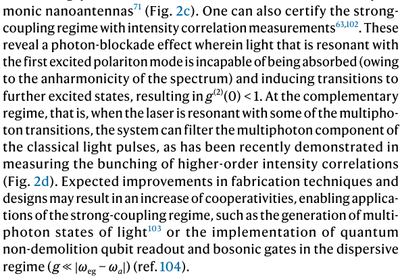
Like most papers, it also cites badly the reference by butchering the name of its first Author as Muñoz C. S. (as it they did not know how to write Spanish names) and, of course, the term "bundle" is not used. I would not quite trust this review for an accurate account of the other papers. It's funny that Larson seems to understand the bundler much better than one of its co-Authors!
The perovskite people seem to like the idea as they see the bundler as a potential beneficiary of their emitters. This is from Raino et al.:[2]

And this is from Cherniukh et al.:[3]

Hamsen et al.[4] comment on direct production under strong driving:

Cygorek et al.[5] quote the bundler as an application of the fluorescence of quantum dots:

• • Pscherer et al.[6] highlight the bundler and use the term, although as an application of many emitters, which might even be correct, but properly speaking, the application should go with the single-molecule listing:

Shi et al.[7] cite the bundler for single photons or photons pairs, which is missing the main point:

• • • Bin et al.[8] port the idea to a different (phonon) platform. They retain the term. I am an author but the main work is from the other group(s). This started a whole activity on bundling with phonons (with a separate branch not quoting the original paper anymore, e.g., in 2022, this paper was more cited [23 times] than the bundler itself [22]):

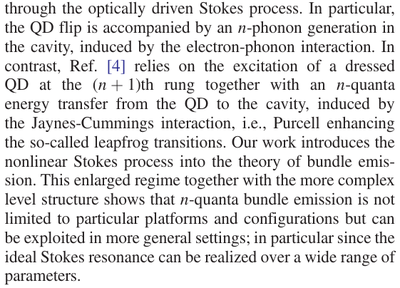
• Müller et al.[9] rightfully point at the future of the results reported in this text. Although we are authors, most of the work (even theoretical) is from the Vuckovic group and we acted more as consultants on this one, in particular due to our role in planting the seminal idea:
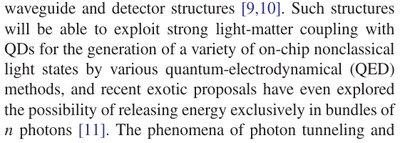
• • • Bin et al.[10] add parity-protection (suppressing even-number bundles) and ultrastrong-coupling dynamics. The bundler paper is cited many times, as various of its concepts, techniques and resulted are used.

• Fischer et al.[12]refers to the temporal structure of the bundle:
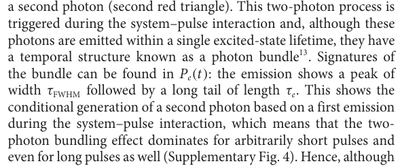
• Boos et al.[13] suggest a time-resolved bundling emission:

Fischer et al.[14] cite the bundler as one of the "multi-photon quantum state generators":

• • • Liu et al.[15], in an already highly-cited paper, although in an obscure journal, study STIRAP technique for high photon-number bundle generation:
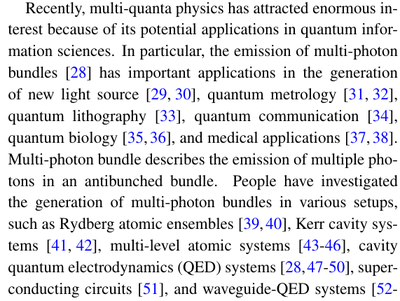
Heindel et al.[16] make a general reference:

Kuruma et al.[17] make the technology required for the bundler in the future:
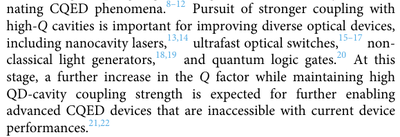
• Kockum et al.[18] refers to the bundle which could be produced by frequency conversion:
• • • Ma et al.[19] study bundle generations from a Josephson junction:

Krisnanda et al.[20] cites the bundler in connection with NOON states, possibly mistaking this with the superposition ${1\over\sqrt{2}}(\ket{0\mathrm{g}}+\ket{N\mathrm{e}})$:

• • • Yuan et al.[21] bring the scheme to magnons.
• Groiseau et al.[22] comment on (two-photon) bundling opportunities from their THz single-photon source:

Qiang et al.[23] report superbunching from perovskites and link that, maybe hurriedly, to entangled multi-photon quantum light:
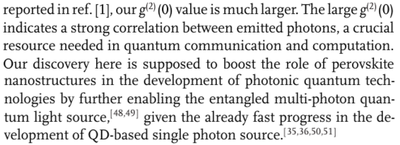
Rundquist et al.[24] limit the bundler to two-photon emission and attribute themselves the potential of generalization:
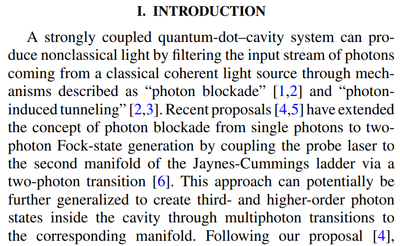
Rivera17a et al.[25] bundle the bundler in a list of references that study two-photon spontaneous emission:

Müller et al.[26], in a sister paper to Ref. [9], cites the bundler for potential applications:
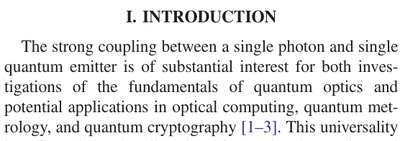
Fischer et al.[27] again pack up the bundler among multi-photon quantum state generators:

• Rivera et al.[28] compare their Fock-laser to the bundler:
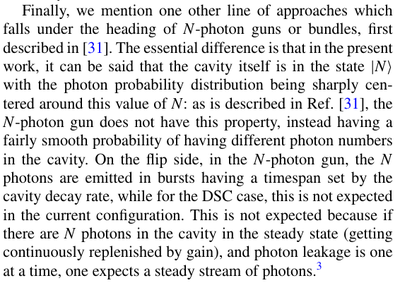
Gu et al.[29] cite the bundler as a general $n$-photon source.

• Nair et al.[30] say that the ultra-strong coupling regime leads to newer possibilities such as the production of output fields in Fock states, suggesting they do not understand the bundling mechanism (that relies neither on ultra-strong coupling nor, which is more subtle, does it produce Fock states):
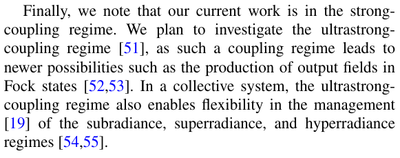
• Pashaei Adl et al.[31] again with perovskites refer to bundles or "bursts"


Groiseau et al.[32] make the incorrect statement that the bundler is (like other multiphoton sources) low-yield. It is CW so one could say it is intrinsically probabilistic in the form we have presented it:

Template:Nguyen23a et al.[33] ...
Template:Sanchezmunoz20b et al.[34] are inspired by the bundler and its derived papers, although they do not use the term "bundle" (interestingly, Kockum does when Sánchez is not an author):


Arlt et al.[35] cite the bundler as the pursuit of probabilistic multiparticle emitter:

Sloan et al.[36] cite the bundler in connection to medical applications:

• • • Deng et al.[37] study phonon-bundles from a trapped ion, and introduces a distinction between Mollow and parametric down conversion:
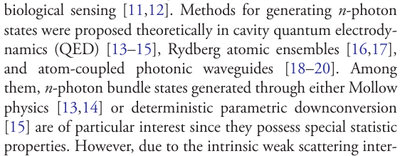
• • • Gou et al.[38]
Chang et al.[39] cites the bundler (without ever using the term "bundle") as a new theoretical proposal using Purcell enhancement on dressed atomic system (not using the term leapfrog either, making the description quite vague and moot) and providing a definition of continuous multiphoton emission.
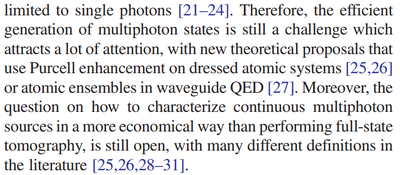

Hendrikson et al.[40] cite the bundler in the context of integrated quantum nonlinear optics:

Fischer et al.[41] identify a regime of low-detuned photon bundling:

Xing et al.[42] ...
Zou et al.[43] ...
Hamsen et al.[44] cite the bundler as an heralded $n$-photon source:

• Rainò et al.[45] describe bundling from superradiant (collective) emission:
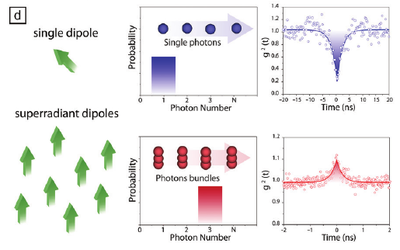
They write in their concluding remark to their paper:
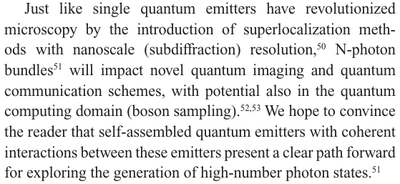
Note that one Author of this note later won the Nobel Prize in Chemistry.
Katsumi et al.[46] cite the bundler (and frequency-filtering!) for "complex photonic quantum states through judicious manipulation")

Cortese et al.[47] cite the bundler as an example of how light-matter hybridization alters quantum properties:

Mavrogordatos[48] cites the bundler for multiphoton transitions as a mark of nonlinearity:

Tang et al.[49] cite the bundler (last citation of the paper) as an example of possible implementation with variations of their scheme:
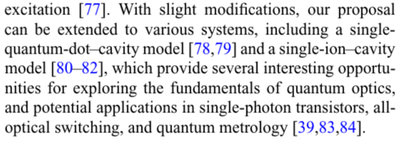
Garziano et al.[50] cite the bundler as an eampleof engineering quantum properties of light emitted by a single emitter:

• Dong et al.[51] discuss multiphoton resonances as bundles:

Their Eq. (29) which is our two-bundle correlation function is also attributed to Glauber (maybe for the particular case $n=1$).
• • • Jiang et al.[52] is maybe the first paper ever to cite the bundler as its first reference and build its narrative from there:

• Snijders et al.[53] relate bundling to 'photon tunelling' that removes the single-photon component:
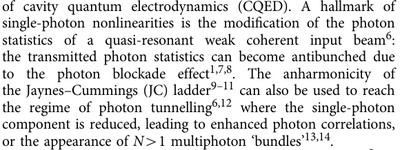
Carlos has his two names in this one but is cited as Mufloz.
Vivas-Viaña & Sánchez Muñoz cite the bundler for the dip in $g^{(2)}$ at the bundling peak; Bundling or bundles are nowhere mentioned:

You et al.[54] refer to the bundler for their investigation of multi-particle van Cittert-Zernike theorem, although it is not always clear why it is included or excluded of the respective statements.


• Gies and Reitzenstein[55]
• Leppäkangas et al.[56] mention photon bundles from cavity physics as compared to their multiphoton Cooper mechanism:

• • • Cosacchi et al.[57]
Bostelmann et al.[58] ...
• • • Zou et al.[59] cite the bundler (Ref. [11]) as a particular case of bundle generation, making an otherwise nice review of bundler-physics:
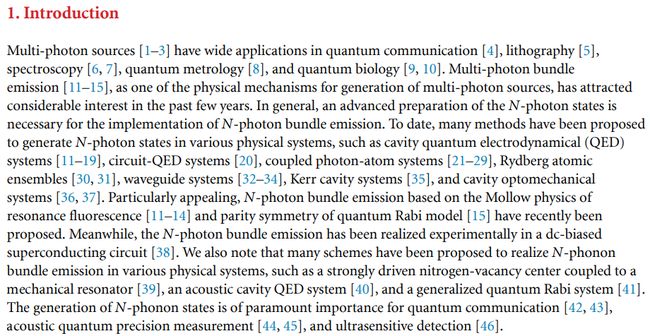
• • • Bin et al.[60] review the early days of cavity QED bundling to introduce her extended scheme:

• Lebreuilly et al.[61] compare their deterministic Fock state creation to the "many" recent other proposals of bundle creation:

• Cosacchi et al.[62] cite the bundler for multi-photon correlation functions:

• Schmidt et al.[63] mention bundles as examples of multiphoton sources:

• Fischer et al.[64] rely on the bundling statistics:
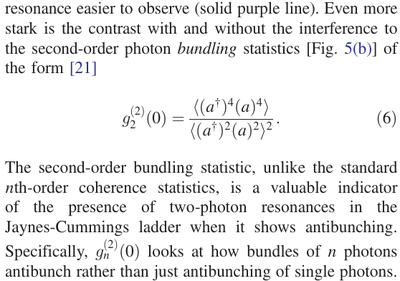
Similarities and differences with the original bundler are pointed out:
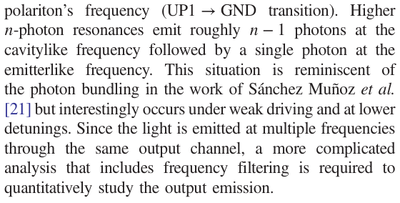
• Stolyarov[65] praises the Jaynes-Cummings model of various feats, including generating bundles:

Dhar et al.[66] cite "nonclassical bundles" as one of the signatures of nonclassical collective features:

Gasparinetti et al.[67] cites the bundler as something useful in quantum photonics, not being quite clear what they mean or how they relate it to the previous work [18]:

Ma et al.[68] cite the bundler for the generalized bundle-statistics:

• Zhang et al.[69] cite the bundler (Ref. [10]) as a new light source, in between many references to bundles:
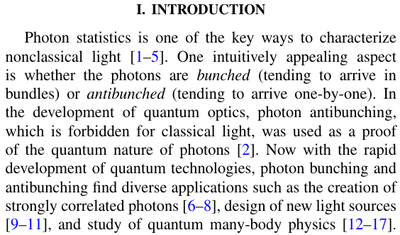
• Li et al.[70] mention the bundler as photonic computing (Ref. 8) in connection with superfluorecence of perovskites. The term "bundles" is later used to describe photon bursts.
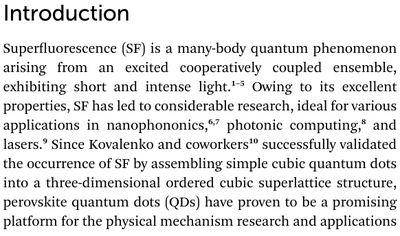
• Zuo et al.[71] propose to use their (spinning) scheme to bundle generation:

López Carreño et al.[72] list the bundler as an exotic source of light:

Rinaldi et al.[74] cite the bundler as an example producing nontrivial statistics. The term bundle is not used for photons, but it is accepted for the optical fibres that are bundled to make a camera:
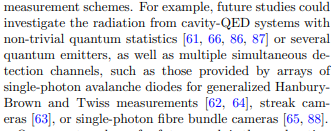
Mavrogordatos[75] cites the bundler for two-photon emission:

Yu et al.[76] cite the bundler as a three-photon emitter:
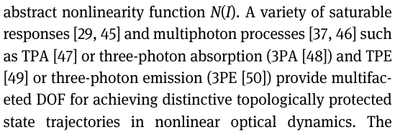
• Müller et al.[78] comment again (cf. [41]) on bundling at low detuning:

Lu et al.[79] ...
Dory et al.[80] comment again on high-order Fock states (cf. Ref. [9]):

Lu et al.[81] speak of tailored higher-order statistics:
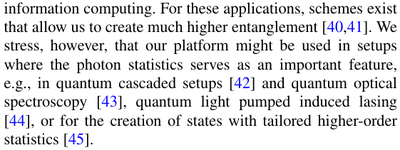
• • • Gou et al.[82] is the second text that places the bundler as its first reference:
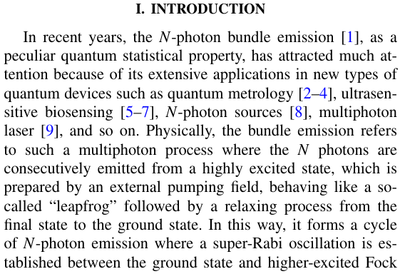
Mîrzac et al.[83] cite the bundler as a novel source of light:

Kamide et al.[84] cite the bundler as a new quantum light source:
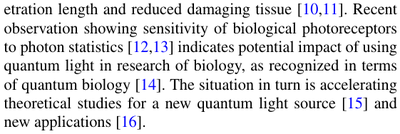
Børkje et al.[85] ...
Strekalov and Leuchs[86] compares bundles to flying Fock states:
References
- ↑ Light–matter interactions in quantum nanophotonic devices. A. González-Tudela, A. Reiserer, J. J. García-Ripoll and F. J. García-Vidal in Nature Rev. Phys. 6:166 (2024).
- ↑ Template:Raino18a
- ↑ Perovskite-type superlattices from lead halide perovskite nanocubes. I. Cherniukh, G. Rainò, T. Stöferle, M. Burian, A. Travesset, D. Naumenko, H. Amenitsch, R. Erni, R. F. Mahrt, M. I. Bodnarchuk and M. V. Kovalenko in Nature 593:535 (2021).
- ↑ Template:Hamsen17a
- ↑ Sublinear Scaling in Non-Markovian Open Quantum Systems Simulations. M. Cygorek, J. Keeling, B. W. Lovett and E. M. Gauger in Phys. Rev. X 14:011010 (2024).
- ↑ Template:Pscherer21a
- ↑ Template:Shi15a
- ↑ $N$-Phonon Bundle Emission via the Stokes Process. Q. Bin, X.-Y Lü, F. P. Laussy, F. Nori and Y. Wu in Phys. Rev. Lett. 124:053601 (2020).
- ↑ 9.0 9.1 9.2 Coherent generation of nonclassical light on chip via detuned photon blockade. K. Müller, A. Rundquist, K. A. Fischer, T. Sarmiento, K. G. Lagoudakis, Y. A. Kelaita, C. Sánchez Muñoz, E. del Valle, F. P. Laussy and J. Vučković in Phys. Rev. Lett. 114:233601 (2015).
- ↑ Parity-Symmetry-Protected Multiphoton Bundle Emission. Q. Bin, Y. Wu and X.-Y. Lü in Phys. Rev. Lett. 127:073602 (2021).
- ↑ Template:Loredo19a
- ↑ Signatures of two-photon pulses from a quantum two-level system. K. Fischer, L. Hanschke, J. Wierzbowski, T. Simmet, C. Dory, J. Finley, J. Vučković and K. Müller in Nature Phys. 13:649 (2017).
- ↑ Signatures of Dynamically Dressed States. K. Boos, S. K. Kim, T. Bracht, F. Sbresny, J. M. Kaspari, M. Cygorek, H. Riedl, F. W. Bopp, W. Rauhaus, C. Calcagno, J. J. Finley, D. E. Reiter and K. Müller in Phys. Rev. Lett. 132:053602 (2024).
- ↑ Scattering into one-dimensional waveguides from a coherently-driven quantum-optical system. K. A. Fischer, R. Trivedi, V. Ramasesh, I. Siddiqi and J. Vučković in Quantum 2:69 (2018).
- ↑ Template:Liu22a
- ↑ Template:Heindel17a
- ↑ Template:Kuruma20a
- ↑ Template:Kockum17a
- ↑ Template:Ma21a
- ↑ Template:Krisnanda21a
- ↑ Template:Yuan23a
- ↑ Single-Photon Source Over the Terahertz Regime. C. Groiseau, A. I. Fernández-Domínguez, D. Martín-Cano and C. S. Muñoz in Phys. Rev. X Quantum 5:010312 (2024).
- ↑ Template:Qiang23a
- ↑ Template:Rundquist14a
- ↑ Template:Rivera17a
- ↑ Template:Muller15b
- ↑ Pulsed Rabi oscillations in quantum two-level systems: beyond the area theorem. K. A. Fischer, L. Hanschke, M. Kremser, J. J. Finley, K. Müller and J. Vučković in Quantum Sci. Technol. 3:014006 (2017).
- ↑ Template:Rivera23a
- ↑ Quantum experiments and hypergraphs: Multiphoton sources for quantum interference, quantum computation and quantum entanglement. X. Gu, L. Chen and M. Krenn in Phys. Rev. A 101:033816 (2020).
- ↑ Template:Nair20a
- ↑ Template:Pashaeiadl23a
- ↑ Proposal for a Deterministic Single-Atom Source of Quasisuperradiant $N$-Photon Pulses. C. Groiseau, A. E. Ellio, d. S. J. Mass and d. S. Parkins in Phys. Rev. Lett. 127:033602 (2021).
- ↑ Template:Nguyen23a
- ↑ Template:Sanchezmunoz20b
- ↑ Arlt et al. arXiv:2210.09981
- ↑ Template:Sloan21a
- ↑ Motional $n$-phonon bundle states of a trapped atom with clock transitions. Y. Deng, T. Shi and S. Yi in Phot. Res. 9:1289 (2021).
- ↑ Antibunched two-mode two-photon bundles via atomic coherence. C. Gou, X. Hu and F. Wang in Phys. Rev. A 106:063718 (2022).
- ↑ Deterministic Down-Converter and Continuous Photon-Pair Source within the Bad-Cavity Limit. Y. Chang, A. González-Tudela, C. S. Mu~noz, C. Navarrete-Benlloch and T. Shi in Phys. Rev. Lett. 117:203602 (2016).
- ↑ Template:Hendrickson14a
- ↑ 41.0 41.1 Self-homodyne measurement of a dynamic Mollow triplet in the solid state. K. A. Fischer, K. Müller, A. Rundquist, T. Sarmiento, A. Y. Piggott, Y. Kelaita, C. Dory, K. G. Lagoudakis and J. Vučković in Nature Phys. 10:163 (2016).
- ↑ Template:Xing24a
- ↑ Template:Zou22a
- ↑ Template:Hamsen18a
- ↑ Superradiant emission from self-assembled light emitters: From molecules to quantum dots. G. Raino, H. Utzat, M. Bawendi and M. Kovalenko in MRS Bull. 45:841 (2020).
- ↑ Template:Katsumi24a
- ↑ Strong coupling of ionizing transitions. E. Cortese, I. Carusotto, R. Colombelli and S. D. Liberato in Optica 6:354 (2019).
- ↑ Template:Mavrogordatos24a
- ↑ Template:Tang19a
- ↑ Cavity QED in the Ultrastrong Coupling Regime: Photon Bunching from the Emission of Individual Dressed Qubits. L. Garziano, A. Ridolfo, S. D. Liberato and S. Savasta in ACS Photonics 4:2345 (2017).
- ↑ Multiphonon interactions between nitrogen-vacancy centers and nanomechanical resonators. X.-L. Dong and P.-B. Li in Phys. Rev. A 100:043825 (2019).
- ↑ Template:Jiang23a
- ↑ Template:Snijders16a
- ↑ Template:You23a
- ↑ Quantum dot micropillar lasers. C. Gies and S. Reitzenstein in Semicond. Sci. Technol. 34:073001 (2019).
- ↑ Template:Leppakangas18a
- ↑ $N$-photon bundle statistics on different solid-state platforms. M. Cosacchi, A. Mielnik-Pyszczorski, T. Seidelmann, M. Cygorek, A. Vagov, D. E. Reiter and V. M. Axt in Phys. Rev. B 106:115304 (2022).
- ↑ Multipartite-entanglement generation in coupled microcavity arrays. M. Bostelmann, S. Wilksen, F. Lohof and C. Gies in Phys. Rev. A 107:032417 (2023).
- ↑ Template:Zou23a
- ↑ Entangled Photon‐Magnon Bundle Emission. Q. Bin, Q. Q, d. Ying and d. X. Lü in Laser Photon. Rev. ':2300977 (2024).
- ↑ Template:Lebreuilly16a
- ↑ Path-integral approach for nonequilibrium multitime correlation functions of open quantum systems coupled to Markovian and non-Markovian environments. M. Cosacchi, M. Cygorek, F. Ungar, A. M. Barth, A. Vagov and V. M. Axt in Phys. Rev. B 98:125302 (2018).
- ↑ Template:Schmidt21a
- ↑ On-Chip Architecture for Self-Homodyned Nonclassical Light. K. A. Fischer, Y. A. Kelaita, N. V. Sapra, C. Dory, K. G. Lagoudakis, K. Müller and J. Vučković in Phys. Rev. Appl. 7:044002 (2017).
- ↑ Template:Stolyarov18a
- ↑ Variational Renormalization Group for Dissipative Spin-Cavity Systems: Periodic Pulses of Nonclassical Photons from Mesoscopic Spin Ensembles. H. S. Dhar, M. Zens, D. O. Krimer and S. Rotter in Phys. Rev. Lett. 121:133601 (2018).
- ↑ Template:Agasparinetti19a
- ↑ Template:Ma22a
- ↑ Template:Zhang18a
- ↑ Template:Li24a
- ↑ Template:Zuo24a
- ↑ Template:Lopezcarreno24a
- ↑ Template:Macovei22a
- ↑ Template:Rinaldi24a
- ↑ Template:Mavrogordatos22a
- ↑ Template:Yu21a
- ↑ Template:Peng22b
- ↑ Template:Muller16a
- ↑ Template:Lu23a
- ↑ Tuning the photon statistics of a strongly coupled nanophotonic system. C. Dory, K. A. Fischer, K. Müller, K. G. Lagoudakis, T. Sarmiento, A. Rundquist, J. L. Zhang, Y. Kelaita, N. V. Sapra and J. Vučković in Phys. Rev. A 95:023804 (2017).
- ↑ Template:Lu17a
- ↑ Hybrid magnon-photon bundle emission from a ferromagnetic-superconducting system. C. Gou, X. Hu, J. Xu and F. Wang in Phys. Rev. Res. 6:023052 (2024).
- ↑ Template:Mirzac21a
- ↑ Template:Kamide17a
- ↑ Nonclassical photon statistics in two-tone continuously driven optomechanics. K. B\orkje, F. Massel and J. G. E. Harris in Phys. Rev. A 104:063507 (2021).
- ↑ Template:Strekalov19a